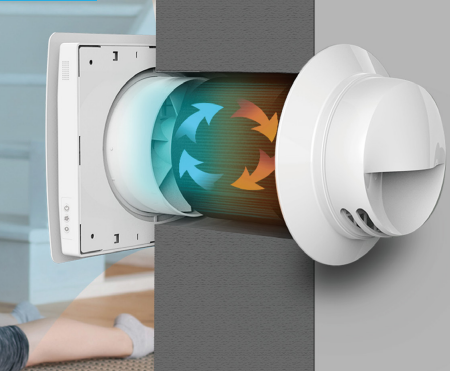Proven Strategies to Clean Your HRV Unit
How Heat Recovery Ventilation Improves Indoor Air Top Quality and Reduces Power Expenses
Heat Recovery Ventilation (HRV) systems play an essential role in improving interior air quality while all at once decreasing energy expenses. By successfully exchanging stagnant indoor air with fresh exterior air, HRVs aid keep ideal humidity and minimize pollutants. Furthermore, their ability to recoup warm from outward bound air reduces the strain on heating and cooling systems. As energy costs remain to increase, comprehending the full capacity of HRV systems ends up being progressively vital for house owners and companies alike.
Comprehending Heat Recovery Ventilation Solutions

Heat recovery ventilation (HRV) systems play an essential function in improving interior air top quality, especially in modern-day, energy-efficient structures. These systems are designed to transfer warmth from the outbound stale air to the inbound fresh air, thus decreasing energy loss while keeping excellent temperature levels inside. HRVs are composed of a warm exchanger, fans, and ductwork, facilitating the continuous flow of air. By eliminating indoor pollutants and introducing fresh air, HRVs aid to stabilize moisture degrees, protect against mold growth, and reduce allergens. The effectiveness of HRV systems hinges on their ability to recuperate approximately 80% of the warm from the exhausted air, advertising energy conservation while guaranteeing a healthy interior atmosphere. Their integration is essential in attaining lasting living techniques.
The Relevance of Indoor Air Top Quality
Indoor air quality (IAQ) is an essential variable affecting the wellness and health of occupants in any kind of atmosphere. Poor IAQ can cause various health concerns, including respiratory system issues, allergies, and exhaustion. Additionally, it can aggravate status quo such as bronchial asthma. Variables adding to reduced IAQ include contaminants from interior sources like cleansing representatives, mold, and poor ventilation. As a result, keeping excellent IAQ is essential for advertising a risk-free and comfortable living or functioning space. Reliable methods to improve IAQ entail routine tracking of air quality, correct ventilation systems, and lessening using hazardous materials indoors. By prioritizing IAQ, individuals can ensure a much healthier setting that fosters efficiency and total lifestyle.
Energy Performance Perks of HRV Solutions
Lots of property owners and building supervisors are increasingly recognizing the power efficiency advantages of warm recovery air flow (HRV) systems. By transferring warm from exhausted indoor air to incoming fresh air, HRV systems substantially minimize the power required for heating & cooling. This procedure decreases dependence on typical HVAC systems, leading to reduced power costs. In addition, HRVs help keep a well balanced indoor climate, protecting against excessive home heating or cooling down needs. The capability to recuperate as much as 90% of the warmth from outward bound air additionally supports sustainability efforts by decreasing overall power intake. Subsequently, HRV systems add not only to set you back financial savings however additionally to a reduced carbon impact, straightening with the expanding focus on energy-efficient building methods.
Installment and Upkeep Considerations
The efficient implementation of heat healing air flow (HRV) systems needs cautious factor to consider of setup and maintenance elements to ensure peak performance. Proper positioning of the HRV unit is necessary, as it must be set up in a place that maximizes airflow additional hints while decreasing sound interruption. Furthermore, ductwork needs to be properly sized and insulated to prevent power loss. Regular maintenance, including filter replacement and system cleaning, is essential to secure ideal capability and interior air high quality. Owners must establish a routine upkeep routine to determine and attend to prospective problems before they intensify. Collaboration with skilled professionals throughout both installation and maintenance stages can boost the long life and effectiveness of HRV systems, ultimately bring about better interior atmospheres and lowered energy costs.
Real-World Applications and Success Stories
Discovering real-world applications of heat healing ventilation (HRV) systems exposes their substantial influence on indoor air quality and energy performance throughout numerous setups. In household structures, home owners have actually reported better air high quality, leading to fewer allergies and breathing issues. Schools applying HRV systems have kept in mind enhanced trainee concentration and reduced absenteeism as a result of better ventilation. Commercial structures, such as workplaces and retail spaces, have experienced reduced power expenses and boosted staff member performance. As an example, a corporate workplace in a warm climate achieved a 30% decrease original site in power costs after mounting an HRV system. These success stories demonstrate that HRV technology not only adds to healthier atmospheres however likewise provides concrete financial advantages, making it an important financial investment for various markets.
Regularly Asked Inquiries
Can HRV Solutions Minimize Allergens in Indoor Air?
The efficiency of HRV systems in decreasing interior allergens largely rests on their capability to filter and exchange air. HRV Heat Recovery Ventilation. By constantly replacing stagnant air, these systems can significantly lower allergen levels throughout indoor settings

Just How Does Moisture Affect HRV System Performance?
Humidity considerably affects HRV system efficiency; high levels can cause condensation, lowering effectiveness, while reduced humidity might boost air exchange. Balancing humidity is crucial for excellent operation and maintaining indoor air high quality.
Are HRV Systems Noisy During Operation?
HRV systems can produce varying sound levels during procedure, depending upon their layout and setup. Some systems operate quietly, while others may produce noticeable audio, especially at higher air movement settings or when poorly preserved.
What Is the Ordinary Lifespan of an HRV System?

Can HRV Equipments Be Made Use Of in All Environments?
HRV systems can be utilized in different environments, but their performance might differ - HRV Heat Recovery Ventilation. In extreme temperatures, adjustments or extra systems could be essential to guarantee excellent performance and comfort while keeping interior air high quality